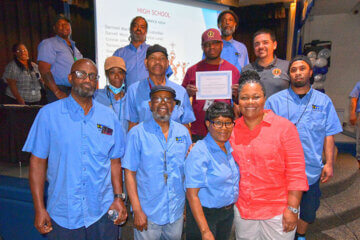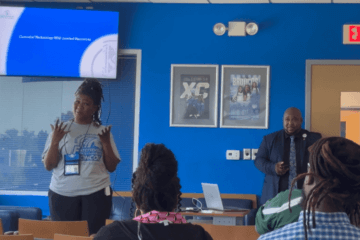There’s nothing like a good success story — and the University of Minnesota’s Office of Classroom Management has an amazing one. The quality control data they’ve tracked over the years dramatically illustrates their team’s triumph. (So do the before-and-after photos!)
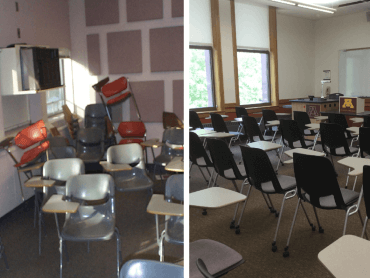
Because their student team uses OrangeQC on campus, we got to sit in on a talk that UMN project coordinators Nick Pnewski and Jessica McCarty gave at the MAPPA 2019 conference. We’re excited to share that story here! It’s a great example of the challenges faced by higher-ed facilities teams. Plus, it gives an innovative example of how to tackle them.
In future articles, we’ll break down how the Office of Classroom Management uses a brigade of student employees to do QC inspections across campus each morning. Then, we’ll explore how they train student employees.
But today, we’re diving into how the office came to be — and how it completely transformed classroom conditions for students and teachers at the University of Minnesota.
The history of the OCM
The University of Minnesota’s Twin Cities campus is the state’s land grant university and a prominent research university. In the fall of 2018, they had about 31,000 undergrad students, 16,000 graduate and professional students, nearly 4,000 faculty members, and over 14,000 staff members.
“We’re working with a lot of people on a daily basis, and a lot of space,” says Jessica.
On top of the sheer size of campus, the buildings themselves were built as far back as 150 years ago. As the decades wore on, more buildings went up. Today, each presents different maintenance challenges from the time period it belongs to.
“[The buildings] are in a lot of different states, and keeping up with the maintenance on them can be difficult,” says Nick. “Because the buildings were so old, the facilities teams were very reactive to what was happening in front of them. It was easy to lose sight of bringing these classrooms to the forefront . . . when you’ve got a chiller that goes down.”
In 1991, the University’s Board of Regents sat down to talk about classroom conditions. The classrooms themselves didn’t meet the regents’ vision for the university. Besides that, faculty and students were becoming frustrated.
“There were a lot of people involved with it, but nobody was actually in charge of it,” says Nick.
“There were just poor standards, if there were any, in the classroom. The physical conditions varied day to day and classroom to classroom. You never knew what you were really getting into,” Nick says.
Additionally, as the ’90s began, instructors were starting to want additional instructional technology. They had access to some programs that brought technology to their classrooms, but there was nothing they could rely on daily.
“The bottom line was that they just weren’t keeping up with the pace that the University was changing at — the way that the instructors actually wanted to teach their classes,” Nick says. “A big change needed to happen.”
In 1995, the Board of Regents did a study to find out what needed to be done. They came up with recommendations for turning things around. For the next few years, the facilities team tried to implement the smaller-scale recommendations.
But by 1998, it was apparent that the changes weren’t enough. The university decided it needed a team dedicated to managing classrooms on campus.
“It just wasn’t cutting it to divvy it out here and make these little improvements,” Nick says. “They really needed someone to sit and advocate for classrooms.”
That’s when the Office of Classroom Management was created.
The ‘champion of the classrooms’
The Office of Classroom Management focuses on caring for spaces so that teaching and learning can flourish. It manages 349 classrooms, 38,000+ square feet of informal learning environments, and 6 computer labs.
“We’re responsible for the physical environments of all these spaces, and that’s the part where our student employees shine,” says Jessica. “We really do see ourselves as the champion of the classrooms, as cheesy as that sounds.”
Because the OCM brings together many functions, it’s able to address a variety of classroom needs quickly.
“By having scheduling, operations, classroom technical services, and planning and development teams all under the same roof, it really allows us to take that holistic approach to managing these classrooms,” says Jessica.
The team views classrooms as a system. If any one component of it breaks down, it could negatively impact the teaching experience.
For example, if the instructor comes in and there are no markers for the whiteboard, that means class stops. A single flickering light or a strange noise in the room can derail students’ attention. All of the little details need to be right for class to go smoothly.
The starting point: Lots of issues, lots of spaces
Pictures from before the OCM show trash left in rooms, abandoned projects, unreported maintenance issues, writing surfaces not cleaned off, furniture arranged haphazardly, and more.
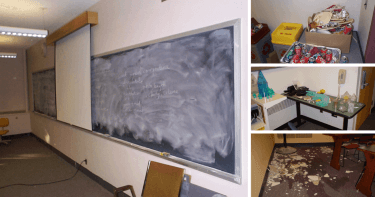
The OCM’s small staff needed to turn things around. But Jessica says they faced a big challenge. “We have a huge array of issues we’re seeing out in these classrooms on a daily basis. We have the furniture issues, we have all the class project equipment being left in rooms, we have trash and food being left behind, undetected maintenance issues, and supply issues . . . How are you expected to find, report, and get all of these problems resolved in a timely manner?”
The key to success: Student employees
When the office started in 1999, they had just one full-time staff member on the ground, doing pen-and-paper inspections and taking photos. It was a struggle to cover much of campus before classes started at 8:00 a.m.
The solution? Students. They covered more ground, worked for less money than a full-time employee, and wanted the short, early-morning hours before class started. The OCM started the classroom condition monitor program in 2002.
“It was just two students, pen and paper, and then the one employee supervising them,” says Nick. “They were just sweeping across campus, getting to as many rooms as possible.”
Today, more than a dozen students are out each morning. They inspect classrooms, fix any simple issues, and report larger problems. Most use iPads equipped with OrangeQC. The mobile inspection software allows them to quickly fill out a form that automatically sends data back to the OCM and alerts the right people about problems.
Back in the office, OCM staff take a look at all the data coming in. Then, they put together a daily report for the Facilities staff that outlines what needs to be done.
“It really streamlined that process, going from pen and paper all the way to OrangeQC, using that software,” says Nick.
Additionally, the reports have helped Facilities become more efficient in how they handle issues. They’re color-coded and broken into categories, helping team managers and supervisors quickly find their areas.
“We’re trying to just get the right information to the right people, so that they can use it for training,” says Nick, or to see that a certain building has a bunch of small issues and someone should go back over it again. “It’s a nice way to give them that information without bogging them down with tickets they’ve got to track.”
The end result: Classrooms ready for learning
The change in classrooms at UMN since the advent of student monitors and mobile inspection software has been dramatic.
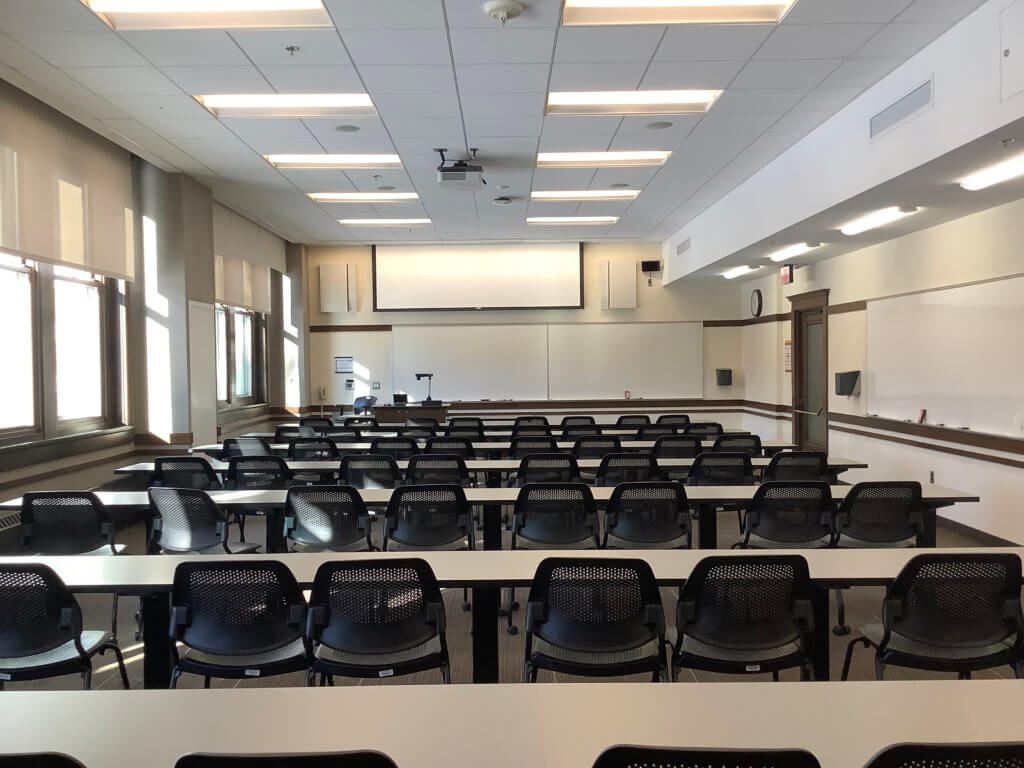
Nick says he was recently digging through data, trying to figure out what the room readiness looked like back in 2005.
“The average I could find was about 41% in that year, and from what supervisors told me, it was probably lower,” he says. “So it was pretty rough out there for the students.”
Today, it’s a much different story.
“In 2019 when we pulled that data, it looked like we were closer to the 95% mark,” he says. “That’s definitely a huge pat on the back for us and Facilities.”
That 41% to 95% jump, more than doubling classroom readiness, is really about how classrooms support teaching and learning at the UMN.
A 54% improvement in classroom readiness is definitely an impressive stat, but the way that change plays out in reality is even more striking.
Back in 2005, that 41% classroom readiness stat was coming from classrooms that weren’t clean and set up for teaching more often than not. More than half the time, students and faculty walked into classrooms that weren’t ready. They were expecting problems daily.
Today, a 95% classroom readiness rate means that students and teachers expect to walk into classrooms that are clean, well-stocked, and ready to go. And when the occasional problem does pop up, they know who to talk to.
“It really has increased the quality of the student experience here at the university,” Nick says. “They know when they walk into a general use classroom what to expect: it’s going to be clean, it’s going to be ready, there should be enough chairs. It’s really improved a lot.”
What all teams can learn from the OCM’s success
As we listened to Jessica and Nick tell the story of the OCM and UMN, a couple strategies stood out to us as applicable to every facilities team, educational or not:
- They centralized (and clarified) responsibility. OCM is clearly the responsible team for making sure classrooms are ready to go. They aren’t the only people working in classrooms, but they’re the central hub for making sure the job got done.
In any team, people need to know who’s responsible for what. (In fact,we’ve heard of hospitals where certain line items were never taken care of because everyone though it was someone else’s responsibility.) That’s especially true for big teams spread out across multiple departments. - They started regular inspections. By creating and expanding the classroom condition monitor program, the OCM made sure those regular inspections were happening. That helped them stay on top of classroom conditions and fix problems quickly.
Whether you’re working with an in-house university team, a BSC, or any other kind of facilities operation, those two points are crucial. Clear responsibility for every part of the process helps everyone work more effectively — and regular inspections mean you know that everyone is following through and getting the job done well.
Thanks so much to the UMN Office of Classroom Management team for letting us share your story!
Next up, we’re going to look at how the OCM empowers student employees to do QC inspections . . . and what you can expect when you manage students. Finally, we’ll dive deeper into how to train student employees.
Is your team performing APPA inspections? Our guide to APPA quality standards helps explains the basics.


